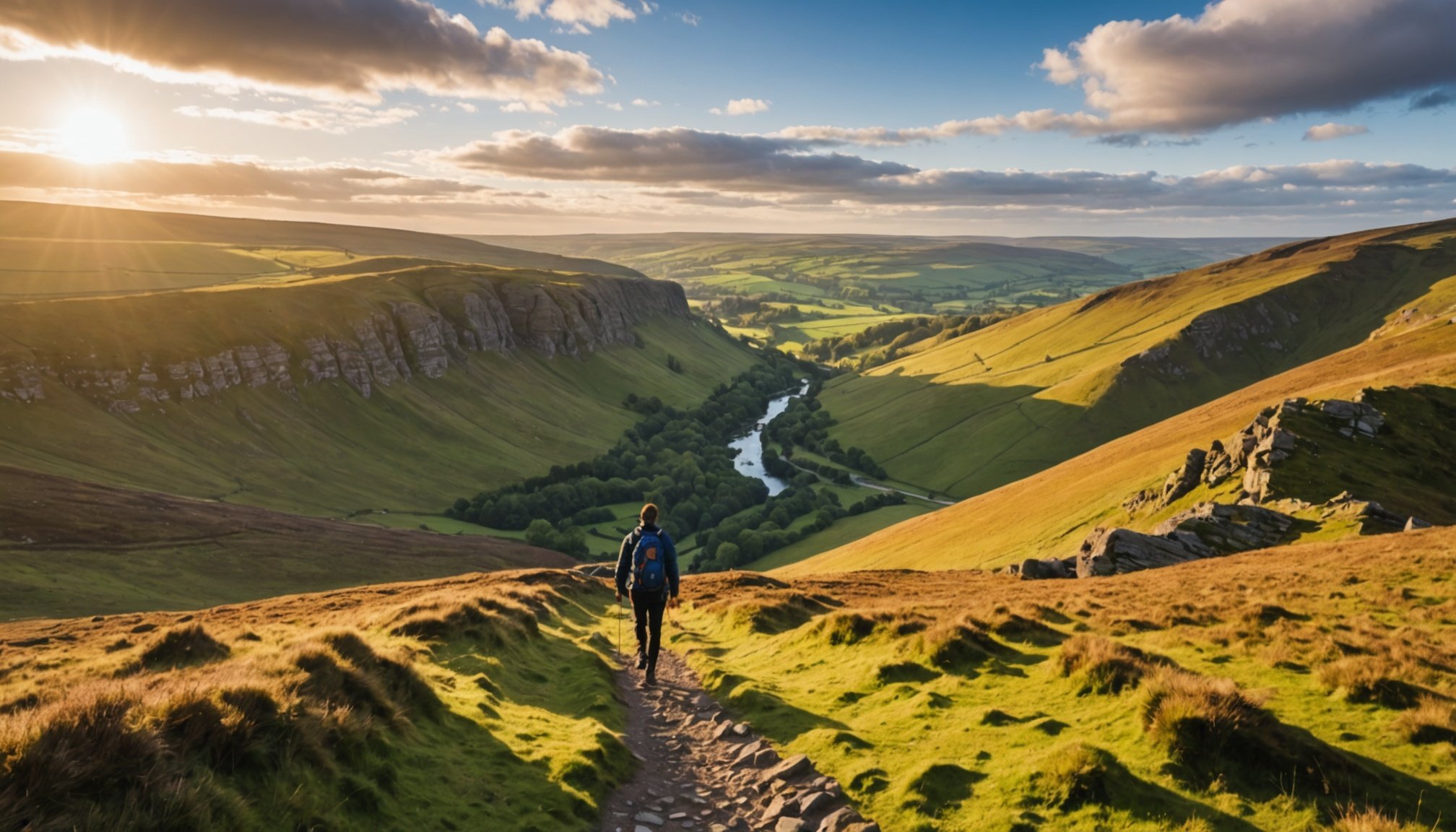Overview of the Peak District
The Peak District, renowned as a premier hiking destination, offers breathtaking landscapes that beckon outdoor enthusiasts. As the first designated national park in the UK, it boasts a diverse array of geographical features—from dramatic limestone dales to pristine moorlands. These varied terrains provide a haven not only for hikers but for nature lovers seeking scenic beauty and adventure.
Beyond its natural allure, the Peak District plays a vital role in outdoor recreation and tourism. It attracts millions annually, contributing significantly to local economies while promoting environmental appreciation and conservation. With trails that range from leisurely strolls to challenging climbs, the park accommodates all skill levels.
Topic to read : Discover budget-friendly vw campervan rentals for your kent adventure!
Hiking here is more than just a physical activity; it’s an immersive experience into the heart of the British countryside. Whether trekking through the rugged peaks or exploring tranquil valleys, visitors can enjoy an unparalleled encounter with nature. The Peak District’s charm lies in its ability to offer solitude, beauty, and an invigorating escape from urban life, confirming its status as one of the UK’s top hiking sanctuaries.
Top Hiking Trails in the Peak District
Explore the hiking trails of the Peak District, where each path offers unique encounters with nature. Discover the top three trails and their allure.
Also to discover : Explore Top Lake District Getaways for Memorable Birdwatching Adventures
Trail 1: Kinder Scout
The Kinder Scout trail stands out as a favourite. Known for its high plateau, this trail offers panoramic views that captivate hikers. Rated as moderately challenging, Kinder Scout presents rugged terrain and moorland landscapes. It’s accessible from Edale, with well-marked paths guiding adventurers through its wonders. Unique elements, such as the stunning Kinder Downfall, add to the enchantment.
Trail 2: Mam Tor
The Mam Tor trail is renowned for breathtaking vistas. It’s best hiked in the morning or late afternoon to capture its charm. Featuring rolling hills and the iconic “Shivering Mountain,” Mam Tor is suitable for moderate skill levels. When visiting, pack a camera to capture the scenery. Using walking poles can enhance stability on hillier sections.
Trail 3: The Great Ridge
Journey along The Great Ridge between Castleton and Mam Tor for a picturesque hike. This trail affords scenic views and numerous photography spots, including the enchanting Hope Valley. It’s advisable to carry ample water and use sturdy boots due to uneven paths. Appreciate the charm of the Peak District while navigating its ridges.
Recommended Accommodations
Exploring the Peak District is made even more enjoyable with an array of lodging options to suit every traveler’s preference. From quaint hostels to charming camping sites, there’s a choice for everyone looking to unwind after a day of adventure.
For families seeking comfort and convenience, numerous family-friendly lodgings offer spacious rooms and easy access to local attractions, making them ideal for those with young children. Meanwhile, for those in search of a rustic experience, camping sites scattered throughout the park enable visitors to immerse themselves fully in the natural beauty surrounding them.
Consider unique stays, such as converted barns or rustic cabins, which allow for a truly immersive Peak District experience. These options often provide stunning views right from your doorstep, letting you wake up to the pristine landscapes you came to enjoy.
Whether you’re in search of a cosy bed-and-breakfast or a more rugged campsite, the Peak District’s accommodation offerings ensure a pleasant stay that complements your outdoor adventures. Plan ahead to secure the best spots, especially during peak tourist seasons, to make the most of your visit.
Essential Gear for Hiking
Having the right hiking gear is crucial for a safe and enjoyable adventure in the Peak District. At the top of your packing list should be weather-appropriate clothing, ensuring you stay comfortable and protected from the elements. Layering is key, as temperatures can shift rapidly across different terrains. Include a waterproof jacket and sturdy hiking boots to handle both rainy moorlands and rocky paths.
Outdoor essentials such as a map and compass are indispensable for navigating trails, especially where GPS signals may falter. It’s also wise to carry a fully charged mobile phone and a portable charger for emergencies. Must-have safety gear includes a whistle, first-aid kit, and a headlamp, vital for unforeseen circumstances or late returns.
Modern hikers often leverage technology with apps for offline maps or weather updates. Additionally, packing plenty of water and high-energy snacks is necessary to sustain energy levels during strenuous hikes.
Prioritise reducing environmental impact; use reusable bottles and containers. With these items, you’re well-equipped to embrace everything the Peak District has to offer, from its towering peaks to serene valleys.
Safety Tips for Hiking
Embarking on a hike in the Peak District requires a keen focus on hiking safety. It’s essential to prepare for potential emergencies by packing a well-equipped first aid kit, carrying a whistle, and informing someone of your route. These steps ensure you are better prepared for unexpected situations.
Weather in this picturesque national park can shift unexpectedly. Layering remains crucial; wear breathable, waterproof clothing to withstand rain and wind, ensuring weather conditions won’t disrupt your adventure. Check forecasts before setting out, and adjust your plans accordingly, particularly during inclement weather.
Practising responsible trail etiquette fosters a safer, more enjoyable environment for everyone. Stay on marked paths to reduce environmental impact and prevent soil erosion. Yield to uphill hikers and slower walkers, maintaining a courteous and safe distance. Additionally, pack out all waste to preserve the natural beauty of this beloved hiking destination.
By following these guidelines, you contribute to a safer, more enjoyable hiking experience in the Peak District, allowing everyone to appreciate its stunning landscapes responsibly and with peace of mind.
Scenic Viewpoints and Hidden Gems
Scenic viewpoints within the Peak District are plentiful and perfect for photography enthusiasts. To capture the park’s essence, start with Surprise View, a spot offering panoramic vistas of Hope Valley, especially captivating during sunrise. Its elevation provides an ideal backdrop for stunning photos.
Beyond popular sites, several hidden gems await exploration. The Lathkill Dale offers serenity with its crystal-clear river and limestone scenery, a less-trodden path that promises tranquillity. Consider venturing to Three Shires Head, where crossing rivers meets picturesque landscapes, delivering an enchanting scene that’s less frequented by tourists.
Planning is key to maximize your visit. Begin early to catch the best light and avoid crowds at known spots, ensuring a more personal encounter with nature’s beauty. For those eager to discover lesser-known trails, local visitor centres can offer guidance on secret pathways, enhancing your itinerary.
Embrace these locations for both their photography opportunities and their serene settings. Whether you’re capturing the sun-drenched hills or simply soaking in the solitude, the Peak District’s viewpoints and hidden treasures offer unforgettable experiences.
Seasonal Advice for Hiking in the Peak District
Understanding seasonal hiking in the Peak District can enhance your experience significantly. The park’s weather conditions are as diverse as its landscapes, offering distinctive experiences throughout the year.
Each season brings its own charm. Spring unveils vibrant wildflowers and milder temperatures, making it ideal for picturesque hikes under clear skies. Summer offers extended daylight for longer treks but expect busier trails. It’s essential to stay hydrated and use sun protection during these warmer months.
Autumn brings breathtaking foliage, with crisp air and quieter paths, perfect for absorbing the natural beauty in solitude. Winter, while serene, can present challenges with frosty trails and unpredictable weather conditions, requiring appropriate clothing and preparedness for icy conditions.
Adapting your hiking gear to each season is crucial. In Spring and Autumn, layering is the key. Light, breathable clothing works best in Summer, while insulated layers and waterproofs are necessary for Winter. Wintry conditions also necessitate extra caution and gear like microspikes for added traction on slippery paths.
By understanding and planning for seasonal changes, you can enjoy the Peak District in its full splendour, embracing each distinctive phase with preparation and respect for nature’s rhythm.











